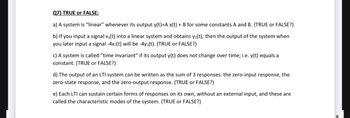
Introductory Circuit Analysis (13th Edition)
13th Edition
ISBN: 9780133923605
Author: Robert L. Boylestad
Publisher: PEARSON
expand_more
expand_more
format_list_bulleted
Question

Transcribed Image Text:Q7) TRUE or FALSE:
a) A system is "linear" whenever its output y(t)=A x(t) + B for some constants A and B. (TRUE or FALSE?)
b) If you input a signal x₁(t) into a linear system and obtains y₁(t); then the output of the system when
you later input a signal -4x1(t) will be -4y₁(t). (TRUE or FALSE?)
c) A system is called "time invariant" if its output y(t) does not change over time; i.e. y(t) equals a
constant. (TRUE or FALSE?)
d) The output of an LTI system can be written as the sum of 3 responses: the zero-input response, the
zero-state response, and the zero-output response. (TRUE or FALSE?)
e) Each LTI can sustain certain forms of responses on its own, without an external input, and these are
called the characteristic modes of the system. (TRUE or FALSE?)
Expert Solution
arrow_forward
Step 1
Since you have posted a question with multiple sub-parts, we will solve the first three sub-parts for you. To get the remaining sub-part solved please repost the complete question and
mention the sub-parts to be solved.
Linear System:-
- A linear system is a mathematical representation of a system in systems theory that relies on the application of a linear operator.
- Compared to nonlinear systems, linear systems often have significantly simpler traits and properties.
Non-Linear System:-
- A larger class of systems that do not adhere to the superposition principle are covered by nonlinear control theory.
- Since all genuine control systems are nonlinear, it applies to more real-world systems.
- In many cases, nonlinear differential equations regulate these systems.
Step by stepSolved in 4 steps

Knowledge Booster
Learn more about
Need a deep-dive on the concept behind this application? Look no further. Learn more about this topic, electrical-engineering and related others by exploring similar questions and additional content below.Similar questions
- 2. a. For the circuit below, find the differential equation for vi(t) as a function of vs(t) when is(t) = 0. Make sure the coefficient in front of the highest order derivative term is unity. b. For the circuit below, find the differential equation for vi(t) as a function of is(t), when vs(t) = 0. Make sure the coefficient in front of the highest order derivative term is unity. vs(t) + 2 H 0.25 F is(t) + Ve 202 +arrow_forwardConsider the function given below. Determine, by presenting proof, whether the given function is causal and BIBO-stable. a(t) = 4 rect ()arrow_forwardH.W. 7: Design a noninverting amplifier with a gain of 2, At the maximum output voltage of 10 V the current in the voltage divider is to be 10 µA.arrow_forward
arrow_back_ios
arrow_forward_ios
Recommended textbooks for you
 Introductory Circuit Analysis (13th Edition)Electrical EngineeringISBN:9780133923605Author:Robert L. BoylestadPublisher:PEARSON
Introductory Circuit Analysis (13th Edition)Electrical EngineeringISBN:9780133923605Author:Robert L. BoylestadPublisher:PEARSON Delmar's Standard Textbook Of ElectricityElectrical EngineeringISBN:9781337900348Author:Stephen L. HermanPublisher:Cengage Learning
Delmar's Standard Textbook Of ElectricityElectrical EngineeringISBN:9781337900348Author:Stephen L. HermanPublisher:Cengage Learning Programmable Logic ControllersElectrical EngineeringISBN:9780073373843Author:Frank D. PetruzellaPublisher:McGraw-Hill Education
Programmable Logic ControllersElectrical EngineeringISBN:9780073373843Author:Frank D. PetruzellaPublisher:McGraw-Hill Education Fundamentals of Electric CircuitsElectrical EngineeringISBN:9780078028229Author:Charles K Alexander, Matthew SadikuPublisher:McGraw-Hill Education
Fundamentals of Electric CircuitsElectrical EngineeringISBN:9780078028229Author:Charles K Alexander, Matthew SadikuPublisher:McGraw-Hill Education Electric Circuits. (11th Edition)Electrical EngineeringISBN:9780134746968Author:James W. Nilsson, Susan RiedelPublisher:PEARSON
Electric Circuits. (11th Edition)Electrical EngineeringISBN:9780134746968Author:James W. Nilsson, Susan RiedelPublisher:PEARSON Engineering ElectromagneticsElectrical EngineeringISBN:9780078028151Author:Hayt, William H. (william Hart), Jr, BUCK, John A.Publisher:Mcgraw-hill Education,
Engineering ElectromagneticsElectrical EngineeringISBN:9780078028151Author:Hayt, William H. (william Hart), Jr, BUCK, John A.Publisher:Mcgraw-hill Education,

Introductory Circuit Analysis (13th Edition)
Electrical Engineering
ISBN:9780133923605
Author:Robert L. Boylestad
Publisher:PEARSON

Delmar's Standard Textbook Of Electricity
Electrical Engineering
ISBN:9781337900348
Author:Stephen L. Herman
Publisher:Cengage Learning

Programmable Logic Controllers
Electrical Engineering
ISBN:9780073373843
Author:Frank D. Petruzella
Publisher:McGraw-Hill Education

Fundamentals of Electric Circuits
Electrical Engineering
ISBN:9780078028229
Author:Charles K Alexander, Matthew Sadiku
Publisher:McGraw-Hill Education

Electric Circuits. (11th Edition)
Electrical Engineering
ISBN:9780134746968
Author:James W. Nilsson, Susan Riedel
Publisher:PEARSON

Engineering Electromagnetics
Electrical Engineering
ISBN:9780078028151
Author:Hayt, William H. (william Hart), Jr, BUCK, John A.
Publisher:Mcgraw-hill Education,